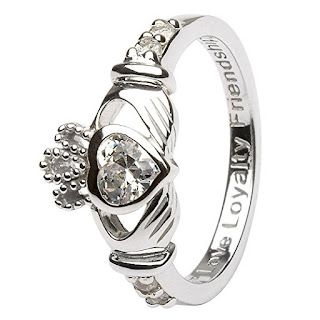Thinking of planning a Scottish themed wedding? Whether you want to celebrate your Scottish heritage or just want to add a Celtic flair to your wedding, you will find a wealth of Scottish wedding traditions available . Before I get into some of these customs, I have to mention that one tradition historically practiced was a “trial wedding.” This was still a ceremony and was formalized by handfasting, but this trial marriage lasted for one year and a day. When it “expired” the couple chose to get married or to separate. Children produced during this time were considered legitimate, and really it was considered a way to determine the bride’s fertility. Today, many Scottish wedding traditions have evolved to suit modern times. Here are a 6 wedding traditions you can adapt for your own wedding.
 |
| The Caim is a prayer of protection for the marriage. |
Caim: Prayer of Protection
The caim is a prayer said while the bride and groom stand in a sacred circle at the altar. The purpose of this prayer is protection of the bride and groom at the time of marriage and the circle is thought to symbolize unity, community and a connection to the greater universe. Historically this circle was drawn by a sword or lance around the couple.
Today, the tradition of cutting the circle
has vanished, but the prayer remains and is said as the couple draws a circle
around themselves. These caims follow a certain rhyme and meter which gives the
ceremony a more revered feeling. Today’s brides and grooms can create their own
prayer just like they write their own wedding vows to make their wedding
ceremony more meaningful or can choose a historic celtic prayer if they want to hold on to that historic element.
Oathing stone
The ancient Celtic tradition of the oathing stone is tied to the origins of the wedding vow. Back then the Celts were tribal people and closely connected to the spirit of the place where they lived. As a result, important vows were made in very precise places and were considered sacred because they believed certain ancestral spirits were associated with these places. This connection was a critical element for gaining a blessing on any new venture including marriage.
The oathing stone was held by the officiant and represented
a way to link the couple with the land as well as those ancestral blessings like a
bridge as they said their vows. Today, couples decorate small stones by etching
or painting the bride’s and groom’s names or initials or the date of their
wedding on the stone. It is thought to root the couple’s future in the wisdom
of the past at the beginning of their life together. Then the stone is thrown
into a lake or the sea, or can be reverentially placed in a place special to
the couple.
Scottish handfasting tartan
Handfasting is the Scottish tradition with a couple of meanings. It was used as a
way to show an intent to marry (engagement) and part of a betrothal ceremony. But in this case, if the couple had sex following a handfasting ceremony, they were considered
married rather than just engaged. As part of the actual wedding ceremony, this tradition of handfasting can also be traced
back to the 1500s as part of the Celtic tradition. During this ceremony the guests
circled around the bride and groom as they made their vows to one another, and as
they did, their hands were gently fastened together using a cord or strip of
cloth (preferably a tartan).
3 other Scottish wedding traditions
 |
| Standard Kells Pewter Quaich |
- The bride and groom exchange their vows outside the church doors before going inside for the rest of the ceremony.
- Drinking from the quaich, a two-handled ‘loving cup.’ The couple also drinks from this cup when taking communion together and then they drink from it together during the first toast as a married couple. It represents the couple’s united lives.
- Throwing of wedding confetti. Today Scottish wedding confetti can consist of paper colored like Tartan plaid and includes shapes like shamrocks.
For those who want to learn even more about Scottish wedding customs, the groom can wear a kilt, you can pin tartans after vows are exchanged, and include bagpipe music. If you have more ideas, I’d love to hear them.
* * *
Some links in this post are affiliate links. We are a participant in the Amazon Services LLC Associates Program, an affiliate advertising program designed to provide a means for us to earn fees by linking to amazon.com and affiliate sites.










